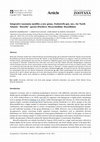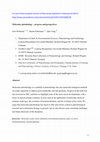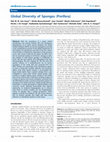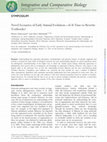Papers by Martin Dohrmann

Zootaxa, 2012
Molecular systematic studies have indicated that the hexactinellid sponge species Rossella nodast... more Molecular systematic studies have indicated that the hexactinellid sponge species Rossella nodastrella Topsent (Lyssacinosida, Rossellidae), previously only known from the NE Atlantic, is only distantly related to its congeners, which are restricted to the Southern Ocean, representing the only case thus far reported of a diphyletic genus in the class Hexactinellida. Here we describe new material of "Rossella" nodastrella from cold-water coral reefs in the NW Atlantic (Florida). Morphological comparison with the holotype from the Azores and specimens recently reported from off Ireland reveal at least two distinct species, which we corroborate with molecular data. Because the diphyletic nature of "Rossella" is further supported with inclusion of the new specimens in the molecular phylogeny, we erect a new genus, Nodastrella gen. nov., for these two species. The Irish specimens are synonymized with our new species Nodastrella asconemaoida sp. nov. Subtle morphological and molecular differences between the E and W Atlantic specimens are for the time being ascribed to intraspecific geographic variation, but indicate that Nodastrella might contain more (sub)species, pending investigation of additional specimens, especially from intermediate locations.

Palaeoworld, 2015
Molecular paleobiology is a subfield of paleontology that uses molecular biological methods on ex... more Molecular paleobiology is a subfield of paleontology that uses molecular biological methods on extant organisms to address geoscientifically relevant questions. Progress in the field was last reviewed in 2007, and here we highlight some of the more recent developments, with a focus on ancient animal evolution, in areas such as the application of molecular clocks to estimate clade ages, the evolution of biomineralization, and the evolution of key traits. We argue that molecular paleobiology has much to offer and will be central to paleontological research and evolutionary biology in general, but we also discuss some remaining challenges and future directions of the discipline. fossils, b) comparative DNA analysis of living organisms, and c) biopolymers from skeletons. However, he was particularly excited about the potential that the new developments in the field of molecular biology provided to address, for example, questions about the origin and early evolution of animals. Yang (1995) basically followed Runnegar's (1986) perspective as "Molecular Palaeontology sensu lato" but distinguished the subfield of "Molecular Palaeontology sensu stricto" as involving only information-encoding molecules, i.e., DNA, RNA, and protein. Subsequent definitions of Molecular Palaeontology (e.g., Schweitzer, 2004, Briggs and Summons, 2014) focused on biomolecules derived from extinct organisms that are preserved in the rock record, such as lipids, hydrocarbons, carbohydrates, proteins, and nucleic acids. These biomolecules show various degrees of resistance to diagenetic processes, from hundreds of millions of years to tens or few hundreds of thousands of years (see Briggs and Summons, 2014: ). Lipids and hydrocarbon "biomarkers" isolated from sedimentary rocks contain only little information about evolutionary relationships or other organismal characteristics but can provide evidence for the past occurrence of certain higherlevel taxa from which no unequivocal body fossils were found (reviewed by Briggs and Summons, 2014, but see also Antcliffe, 2013 for a critical view concerning putative sponge
Advances in Sponge Science: Phylogeny, Systematics, Ecology, 2012

Zoological Journal of the Linnean Society, 2014
ABSTRACT Three new species and a new genus of dictyonal Hexactinellida (Hexasterophora: Sceptrulo... more ABSTRACT Three new species and a new genus of dictyonal Hexactinellida (Hexasterophora: Sceptrulophora: Euretidae and Auloplacidae) are described from hard-bottom communities of the West Indies. The holotypes were all collected by manned submersibles operated by the Harbor Branch Oceanographic Institute between 2006 and 2011, and remained in excellent physical condition at the time of their examination and description. As a result of their relatively recent collection and ethanol storage, molecular markers established previously for the phylogenetics of glass sponges were retrievable from all three holotypes. These are the first sequences for their respective genera, Conorete, Verrucocoeloidea, and Dictyoplax gen. nov. In addition, the first sequences of the genus Lefroyella could be obtained. Because the only (alleged) member of the family Euretidae previously included in molecular phylogenetic studies turned out to belong to the recently resurrected family Auloplacidae (i.e. Dictyoplax gen. nov.), in the present study the phylogenetic position of Euretidae within Sceptrulophora could be inferred for the first time. Furthermore, the increased taxon sampling allowed us to conduct a first test of the monophyly of Euretidae and one of its two subfamilies, Euretinae, with molecular data. Maximum-likelihood phylogenetic analysis revealed a close relationship between Euretidae and Farreidae, but also indicated that Euretidae might be paraphyletic with respect to Farreidae. The monophyly of subfamily Euretinae, at least in its current scope, was strongly rejected by the molecular data, in line with results from other hexactinellid families with a subfamilial division. The genus Sarostegia, which was only recently provisionally moved to Euretidae, is here transferred to an incertae sedis position within the classification of Sceptrulophora, because it is clearly unrelated to the other three included euretids. Besides from that, we refrain from any changes to the classification of Euretidae until more genera of this most diverse but poorly defined sceptrulophoran family are sampled for molecular systematic studies. © 2014 The Linnean Society of London
Zoological Journal of the Linnean Society, 2011

Systematic Biology, 2008
Reconstructing the phylogeny of sponges (Porifera) is one of the remaining challenges to resolve ... more Reconstructing the phylogeny of sponges (Porifera) is one of the remaining challenges to resolve the metazoan Tree of Life and is a prerequisite for understanding early animal evolution. Molecular phylogenetic analyses for two of the three extant classes of the phylum, Demospongiae and Calcarea, are largely incongruent with traditional classifications, most likely because of a paucity of informative morphological characters and high levels of homoplasy. For the third class, Hexactinellida (glass sponges)-predominantly deep-sea inhabitants with unusual morphology and biology-we present the first molecular phylogeny, along with a cladistic analysis of morphological characters. We collected 18S, 28S, and mitochondrial 16S ribosomal DNA sequences of 34 glass sponge species from 27 genera, 9 families, and 3 orders and conducted partitioned Bayesian analyses using RNA secondary structure-specific substitution models (paired-sites models) for stem regions. Bayes factor comparisons of different paired-sites models against each other and conventional (independent-sites) models revealed a significantly better fit of the former but, contrary to previous predictions, the least parameter-rich of the tested paired-sites models provided the best fit to our data. In contrast to Demospongiae and Calcarea, our rDNA phylogeny agrees well with the traditional classification and a previously proposed phylogenetic system, which we ascribe to a more informative morphology in Hexactinellida. We find high support for a close relationship of glass sponges and Demospongiae sensu stricto, though the latter may be paraphyletic with respect to Hexactinellida. Homoscleromorpha appears to be the sister group of Calcarea. Contrary to most previous findings from rDNA, we recover Porifera as monophyletic, although support for this clade is low under paired-sites models. [Bayes factors; data partitioning; Hexactinellida; metazoan phylogeny; model comparison; Porifera; ribosomal DNA; RNA secondary structure.] by guest on February 8, 2016 http://sysbio.oxfordjournals.org/ Downloaded from 2008 DOHRMANN ET AL.-PHYLOGENY OF HEXACTINELLIDA 389 FIGURE 1. Hexactinellid skeletal features. Scanning electron micrographs (SEM). (a) Amphidisc of Hyalonema sp. (HBOI 23-VIII-93-4-001). (b to d) Hexasters. (b) Oxyhexasters of Heterochone calyx (HBOI 20-X-95-3-001). (c) Discohexaster of Rhabdopectella tintinnus (HBOI 4-X-88-2-014). (d) Floricome of Euplectella sp. (HBOI 12-XI-86-1-054). (e) Section of dictyonal framework of Hexactinella carolinensis (HBOI 25-V-92-2-010). (f) Sceptrules. Main picture: sceptrule (in the form of a scopule) from Heterochone sp. (SMF 10523). Inset: sceptrule (in the form of a clavule) from Farrea sp. (courtesy of H. M. Reiswig).

PloS ONE, Apr 27, 2012
With the completion of a single unified classification, the Systema Porifera (SP) and subsequent ... more With the completion of a single unified classification, the Systema Porifera (SP) and subsequent development of an online species database, the World Porifera Database (WPD), we are now equipped to provide a first comprehensive picture of the global biodiversity of the Porifera. An introductory overview of the four classes of the Porifera is followed by a description of the structure of our main source of data for this paper, the WPD. From this we extracted numbers of all ‘known’ sponges to date: the number of valid Recent sponges is established at 8,553, with the vast majority, 83%, belonging to the class Demospongiae. We also mapped for the first time the species richness of a comprehensive set of marine ecoregions of the world, data also extracted from the WPD. Perhaps not surprisingly, these distributions appear to show a strong bias towards collection and taxonomy efforts. Only when species richness is accumulated into large marine realms does a pattern emerge that is also recognized in many other marine animal groups: high numbers in tropical regions, lesser numbers in the colder parts of the world oceans. Preliminary similarity analysis of a matrix of species and marine ecoregions extracted from the WPD failed to yield a consistent hierarchical pattern of ecoregions into marine provinces. Global sponge diversity information is mostly generated in regional projects and resources: results obtained demonstrate that regional approaches to analytical biogeography are at present more likely to achieve insights into the biogeographic history of sponges than a global perspective, which appears currently too ambitious. We also review information on invasive sponges that might well have some influence on distribution patterns of the future.

Paleobiology, 2012
Reconciliation of paleontological and molecular phylogenetic evidence holds great promise for a b... more Reconciliation of paleontological and molecular phylogenetic evidence holds great promise for a better understanding of the temporal succession of cladogenesis and character evolution, especially for taxa with a fragmentary fossil record and uncertain classification. In zoology, studies of this kind have largely been restricted to Bilateria. Hexactinellids (glass sponges) readily lend themselves to test such an approach for early-branching (non-bilaterian) animals: they have a long and rich fossil record, but for certain taxa paleontological evidence is still scarce or ambiguous. Furthermore, there is a lack of consensus for taxonomic interpretations, and discrepancies exist between neontological and paleontological classification systems. Using conservative fossil calibration constraints and the largest molecular phylogenetic data set assembled for this group, we infer divergence times of crown-group Hexactinellida in a Bayesian relaxed molecular clock framework. With some notable exceptions, our results are largely congruent with interpretations of the hexactinellid fossil record, but also indicate long periods of undocumented evolution for several groups. This study illustrates the potential of an integrated molecular/paleobiological approach to reconstructing the evolution of challenging groups of organisms.

Molecular Phylogenetics and Evolution, 2006
Calcareous sponges (Porifera, Calcarea) play an important role for our understanding of early met... more Calcareous sponges (Porifera, Calcarea) play an important role for our understanding of early metazoan evolution, since several molecular studies suggested their closer relationship to Eumetazoa than to the other two sponge &amp;amp;amp;amp;amp;amp;amp;amp;amp;amp;amp;amp;amp;amp;amp;#39;classes,&amp;amp;amp;amp;amp;amp;amp;amp;amp;amp;amp;amp;amp;amp;amp;#39; Demospongiae and Hexactinellida. The division of Calcarea into the subtaxa Calcinea and Calcaronea is well established by now, but their internal relationships remain largely unresolved. Here, we estimate phylogenetic relationships within Calcarea in a Bayesian framework, using full-length 18S and partial 28S ribosomal DNA sequences. Both genes were analyzed separately and in combination and were further partitioned by stem and loop regions, the former being modelled to take non-independence of paired sites into account. By substantially increasing taxon sampling, we show that most of the traditionally recognized supraspecific taxa within Calcinea and Calcaronea are not monophyletic, challenging the existing classification system, while monophyly of Calcinea and Calcaronea is again highly supported.
Molecular Phylogenetics and Evolution, 2009

Integrative and Comparative Biology, 2013
Synopsis Understanding how important phenotypic, developmental, and genomic features of animals o... more Synopsis Understanding how important phenotypic, developmental, and genomic features of animals originated and evolved is essential for many fields of biological research, but such understanding depends on robust hypotheses about the phylogenetic interrelationships of the higher taxa to which the studied species belong. Molecular approaches to phylogenetics have proven able to revolutionize our knowledge of organismal evolution. However, with respect to the deepest splits in the metazoan Tree of Life-the relationships between Bilateria and the four non-bilaterian phyla (Porifera, Placozoa, Ctenophora, and Cnidaria)-no consensus has been reached yet, since a number of different, often contradictory, hypotheses with sometimes spectacular implications have been proposed in recent years. Here, we review the recent literature on the topic and contrast it with more classical perceptions based on analyses of morphological characters. We conclude that the time is not yet ripe to rewrite zoological textbooks and advocate a conservative approach when it comes to developing scenarios of the early evolution of animals.

Hydrobiologia, 2012
Marine sponges of the class Hexactinellida (glass sponges) are among the most understudied groups... more Marine sponges of the class Hexactinellida (glass sponges) are among the most understudied groups of Porifera, and molecular approaches to investigating their evolution have only recently emerged. Although these first results appeared reliable as they largely corroborated morphology-based hypotheses, they were almost exclusively based on ribosomal RNA genes (rDNA) and should, therefore, be further tested with independent types of genetic data, such as protein-coding genes. To this end, we established the mitochondrial-encoded cytochrome oxidase subunit I gene (COI) as an additional marker, and conducted phylogenetic analyses on DNA-and amino-acid level, as well as a supermatrix analysis based on combined COI DNA and rDNA alignments. Furthermore, we increased taxon sampling compared to previous studies by adding seven additional species. The COI-based phylogenies were largely congruent with the rDNA-based phylogeny but suffered from poor bootstrap support for many nodes. However, addition of the COI sequences to the rDNA data set increased resolution of the overall molecular phylogeny. Thus, although obtaining COI sequences from glass sponges turned out to be quite challenging, this gene appears to be a valuable supplement to rDNA data for molecular evolutionary studies of this group. Some implications of our extended phylogeny for the evolution and systematics of Hexactinellida are discussed.
Two new species of the hexactinellid family Tretodictyidae, both collected by submersible, have b... more Two new species of the hexactinellid family Tretodictyidae, both collected by submersible, have been discovered off the coasts of North America. The Pacific species, Tretodictyum montereyensis n. sp., has an unusual skeleton with a fused cortex added over the usual tretodictyid system of ridges and grooves on the dermal surface. The Atlantic species, Hexactinella carolinensis n. sp., is unusual among its congeners in having swollen nodes on the dermal skeleton. Diagnoses of both genera have been modified to accommodate the new findings. The fine diactins of both species are found to have shallow brackets and short barbs, confirming their uncinate nature. Addition of these two species raises the number of known North American tretodictyids from one to three.

Journal of molecular evolution, May 2007
Many rDNA molecular phylogenetic studies result in trees that are incongruent to either alternati... more Many rDNA molecular phylogenetic studies result in trees that are incongruent to either alternative gene tree reconstructions and/or morphological assumptions. One reason for this outcome might be the application of suboptimal phylogenetic substitution models. While the most commonly implemented models describe the evolution of independently evolving characters fairly well, they do not account for character dependencies such as rRNA strands that form a helix in the ribosome. Such nonindependent sites require the use of models that take into account the coevolution of the complete nucleotide pair (doublet). We analyzed 28S rDNA (LSU) demosponge phylogenies using a “doublet” model for pairing sites (rRNA-helices) and compared our findings with the results of “standard” approaches using Bayes factors. We demonstrate that paired and unpaired sites of the same gene result in different reconstructions and that usage of a doublet model leads to more reliable demosponge trees. We show the influence of more sophisticated models on phylogenetic reconstructions of early-branching metazoans and the phylogenetic relationships of demosponge orders.





Uploads
Papers by Martin Dohrmann